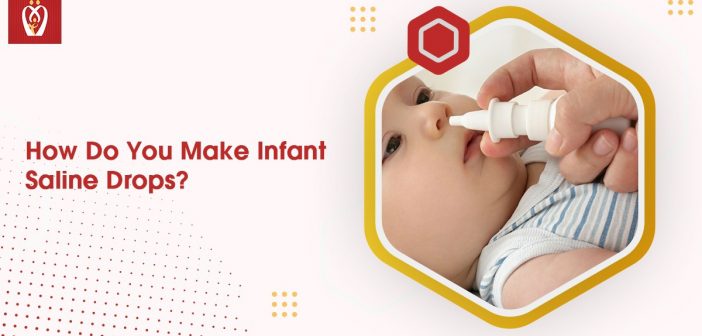Saline drops-The mercury is gently dropping, signaling the arrival of cold winter days. Blocked noses, runny noses, and coughs are prevalent during this season. In adults, a blocked nose produces a lot of irritation, and in infants, it causes breathing issues. During this stage, babies become irritable and grumpy. In babies, it’s critical to eliminate nasal blockage and make breathing easier. Saline is the most excellent way to help you with this. We’ll learn how to produce saline for babies in this article.
Nasal congestion in babies can be relieved naturally with saline. Even at home, saline for babies can be manufactured. Let’s have a look at what saline are and how to make them at home.
What are saline drops, and how do you use them?
- By cleaning nasal passages and sinus congestion, saline drops for babies are an excellent technique to reduce nasal blockage and make breathing easier. Nasal sprays or sinus rinses are other names for them.
- Saline drops lubricate the nasal canal and make clearing congestion with an aspirator simple.
- A few drops of saline in the nasal tube can quickly clear the passage and soothe your kid. Saline nasal drops are effective in infants and neonates and children and adults.
Let’s look at how to utilize saline drops on babies and infants.
How Do I Give My Baby Saline Nasal Drops?
Nasal tissues enlarge with fluids during nasal congestion (stuffy nose). Sinus congestion and a runny nose are also possible side effects. The use of saline for babies can assist you in clearing a nasal obstruction caused by an allergy or a cold.
Follow the guidelines outlined below when delivering nasal drops to newborns.
To begin, thoroughly wash your hands with soap and water.
Using a dropper, administer the prescribed dosage of saline. (For dose, consult your pediatrician.)
Hold your baby in one arm with his head slightly tilted back and a dropper in the other. If there is a lot of mucous, clear it out with an aspirator.
Using a dropper, place saline drops. Make sure the dropper isn’t put into the baby’s nose, as this could cause harm. Instead, squeeze the dropper from the outside, not the inside of the nose.
Hold the position until the saline drips have passed through the nasal canal. It could take a few moments.
Hold your kid upright in a sitting position if he coughs (this can happen if the saline enters the throat).
Make sure you maintain good hygiene after you’ve completed the tasks. Wipe the dropper with a tissue and throw it away. Then, wash the bulb and the dropper many times by sucking water in and squeezing it out using soapy water. Replace the dirty water with clean water and repeat the process.
There are a few things to keep in mind when utilizing saline drops for babies.
Saline drops can be administered up to 2-3 times per day, depending on the condition. However, excessive use of saline can result in pain.
Saline drops for babies should be used before feeding or sleeping to help the infant or baby feel more relaxed while eating or resting.
Warm beverages, such as soup, can be administered to a baby older than six months to keep him hydrated and ease congestion.
When applying saline, remember to be gentle.
Allow the doctor to inspect the infant if the congestion persists and increases and saline drops aren’t working.
What are the advantages?
The following are some of the advantages of saline drops:
Using saline drops or sprays to relieve congestion is natural to ease congestion.
- They have no adverse effects because they do not contain any chemicals (as long as proper cleanliness and safeguards are followed).
- Congestion is relieved quickly with saline.
- Saline can be used by infants, children, and adults.
- They are commonly available in medical stores or made at home without a prescription.
- With these advantages in mind, every mother would want saline drops on hand for her baby. Don’t be concerned! Here’s how to produce your saline at home.
How do you produce your saline drops at home?
It’s easy to make saline drops for babies. Continue reading to learn how to prepare drops for babies
Materials are required.
- 1 cup distilled water or tap water
- A frying pan
- 1/2 teaspoon salt (non-iodized)
- a quarter teaspoon of baking soda (optional)
- Dropper\s
Instructions
- Fill the pot with water. Allow water to boil for 10 minutes to kill germs and contaminants.
- Mix in the salt and baking soda.
- Check if the salt and soda have entirely dissolved in the water.
- Allow the solution to cool completely before using.
- Fill a sterile glass container halfway with the solution.
- To administer the solution, use a sterile dropper.
- Transfer the remaining solution to a clean jar and use the saline from the prepared solution. It should only be kept for a maximum of 24 hours. After 24 hours, it is suggested that the solution be discarded. Before utilizing saline for babies, it is always good to manufacture new ones every day. Also, make sure it’s close to body temperature when you’re using it.
Nasal drops are a simple and efficient approach to calm your baby down. However, before giving your baby saline drops, it’s a good idea to check with your doctor.






